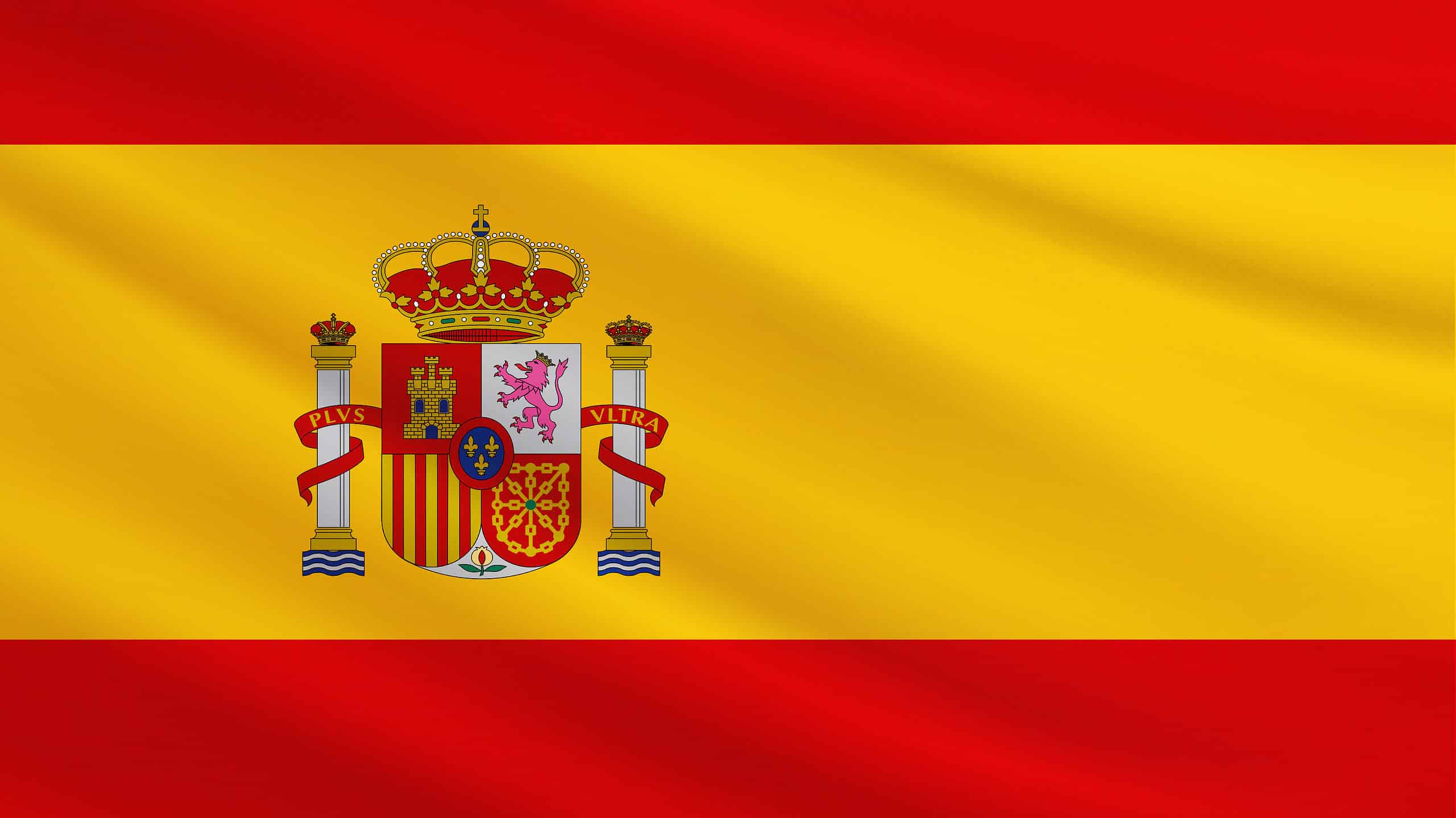Few countries have the name recognition of Spain. It’s a powerhouse on the continent of Europe and in the European Union. Spain sits on the Iberian peninsula, which has been a crossroads of empires since the dawn of humanity, and Spain has collected something from all of these influences along the way. The various regions maintain distinct cultures, but all of them are unmistakably Spanish. Here are 25 fun facts about Spain.
1. Which Came First, the Canary or the Island?

The Canary Islands weren’t named after birds but rather dogs.
©DaLiu/iStock via Getty Images
Spain’s Canary Islands are named after dogs—think of the word “canine.” In the days of yore, it had the Latin name Island of the Dogs (“Insula Canaria”). These islands are Southwest of the Iberian peninsula and just off the coast of the mainland African continent. Romans noted the various wild dogs on the island, giving it its name. There’s still some wildlife on the island.
There are indeed canaries in the Canary Islands, but they are named after the Island.
2. Up There Fun Facts about Spain, Its Highest Peak Is an Active Volcano
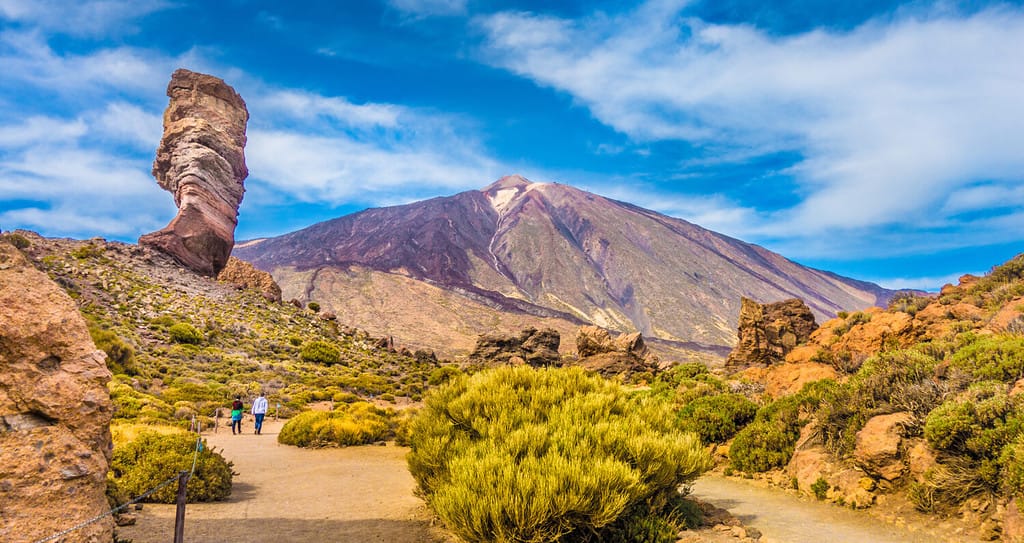
Pico de Teide is the highest mountain in Spain. It’s also an active volcano but has mysterious scrub vegetation that makes for a fascinating sight; they also have some good hiking at this national park.
©canadastock/Shutterstock.com
Pico de Teide is the highest point in Spain. It’s an active volcano rising 12,198 feet (3,718 meters). Despite being an active volcano, there is a cable car to the summit of the peak. The mountain sits on the Canary Island of Tenerife and also has some excellent hiking.
3. The Capital City of Madrid Is the Official Center of the Nation

Madrid, the capital of Spain, is geographically the nation’s bullseye. In fact, all the roads are measured and surveyed from a plaque in the concrete in a plaza in Madrid: Kilometre Zero.
©Sean Pavone/Shutterstock.com
In the middle of Plaza de la Puerta del Sol in Madrid is Kilometre Zero. It is the anchor point for all road measurements in the nation. Looking at a map, the capital city of Madrid sits dead center in the middle of Spain.
There is a plaque on the pavement marking the spot.
4. Rabbits or Hyraxes, Either Way, They’re Part of the Name
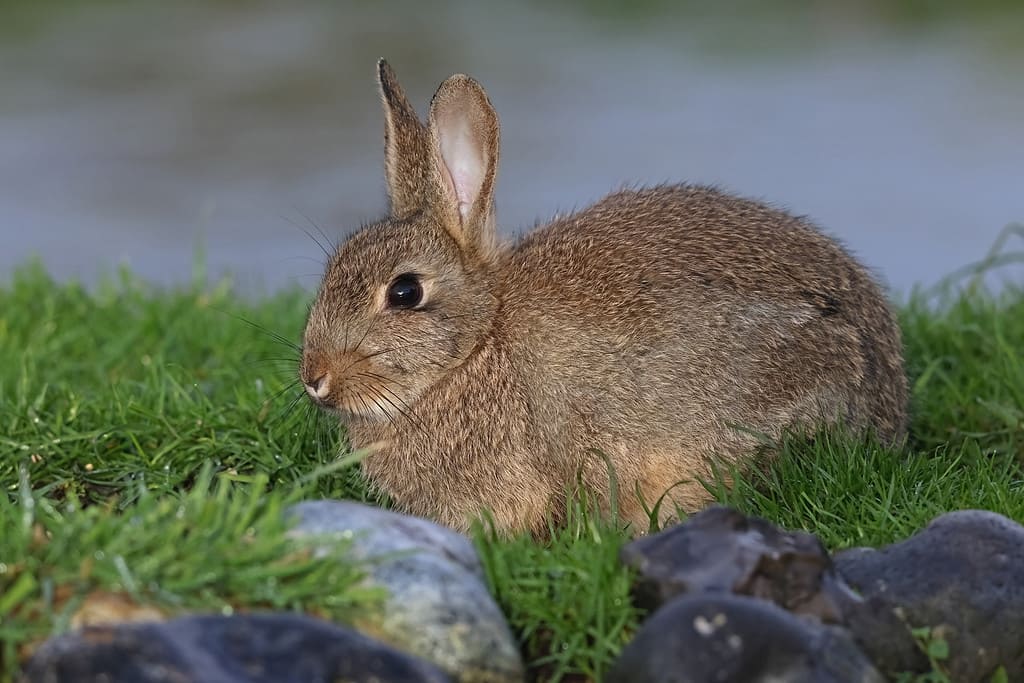
The Phoenicians called the Iberian peninsula the “land of the rabbits.”
©neil bowman/iStock via Getty Images
During the last ice age, glacial melts freed up some migration on the European continent. As such a number of smaller mammals on the Iberian peninsula migrated. The rabbit was one critter that couldn’t get across the terrain, particularly water.
According to legend, the name Spain comes from a Phoenician word meaning “land of the rabbits.” The Phoenicians occupied the territory in ancient times, and there’s a dispute over whether they meant “rock hyraxes” or rabbits. However, The Smithsonian Institute indicates it’s an understandable confusion. Rock hyraxes are also called rock rabbits and look similar, just a little huskier and with shorter ears.
Either way, rabbits are an unexpected essential part of Spanish culture.
5. Food and Fun Facts about Spain, Paella Is Serious Business
Paella is, of course, a big deal in Spain. It appears to be a similar argument to American regions, states, or cities arguing over which barbecue food is the best or which is authentic barbecue.
In the land of rabbits, Paella purists insist that authentic paella must be made with rabbit protein (meat)! Tripadvisor indicates that, at least in Madrid, restaurants are averse to serving rabbit in this dish as it is an unusual protein for most tourists.
However, there is a family of various other delicious paellas, such as paella de marisco (shrimp) and even vegetarian paella (vegetariana).
6. We Got Dibs, Part of Spain Is Completely Surrounded by France
There is a region called Llivia that sits entirely within the territory of France. There is a one-mile sliver between the city and the border of Spain proper.
Llivia goes back to a royal family dispute over marriage and lands. Shrewd negotiators on both teams haggled over words in a contract, specifically what is a “town” and what is a “village.” Ultimately, Spain gave up some other territory to keep this donut hole just across the border, and France was cool with that.
7. Olive Oil? Not Italy, but Spain

Spain is the world leader, by an enormous rate, in the creation, production, and export of olive oil.
©Dusan Zidar/Shutterstock.com
Officially, according to the International Olive Council, Spain is the world’s top producer of olive oil. And not by a little bit. According to the council’s numbers, for the last seven years, Spain soaked the next competitor at least five times over. Italy and Greece clashed over the silver medal during the same period.
8. Cork? Yes, Portugal, but Also Spain
At one time, Spain was the top wine producer worldwide. It’s still in the top three. All that wine needs boxes (haha) or bottles to go in. And those bottles need corks.
One of Spain’s big money-makers is cork. Of course, right next door, Portugal is the world’s leading cork producer. But Spain is right after them. Most cork is used for wine or other bottle stoppers. However, classic badminton shuttlecocks use cork in addition to building materials and other things that need air-tight properties.
9. There Is A Wild Dodgeball Match with Tomatoes in Spain Every Year

Tomatina, in the city of Buñol has unclear origins. But the prospect of hurling tomatoes at each other in a fun but wild modified snowball fight still draws a crowd.
©Kamila Koziol/Shutterstock.com
There are. many facts about Spain that discuss food. But this one is not quite how we might think.
La Tomatina is a slightly safer oddball holiday for those who want a thrill without the danger of the Running of the Bulls. People from all over the world gather in the city of Buñol and hurl soft-ish tomatoes at each other.
Supposedly, 140 tons worth.
And—hey, why not—the celebration starts with a competition to climb a greased pole and retrieve a ham.
Numerous sources note the genesis of this colossal food fight is uncertain. But it genuinely sounds like too much fun to wonder why.
10. Fun Facts about Spain in Space: Both the US and Spain Went to Space
Miguel Eladio López Alegría, a retired NASA astronaut, was born in Madrid. He’s done fourteen International Space Station trips. He’s currently a C-suite officer with Axiom, a commercial space flight firm.
11. Spain Is Big on Hydroelectricity
Spain hosts well over 100 hydroelectric power plants. According to the International Hydropower Association, their latent capacity is 20.4 gigawatts, ranking them at number five in Europe and the top quarter globally.
12. Their National Library Is Gigante

Spain’s National Library has almost 500 people on its staff and over 33 million items in its collections (which include a number of museums).
©Manuel Alvarez/Shutterstock.com
The Biblioteca Nacional de España is in Madrid. And it’s big. The catalog size is listed as 33.1 million items! This size makes it bigger than most Ivy League universities’ libraries.
It’s connected to the National Museum of Architecture. It’s not just for academics either; it’s a public library. There are almost 500 staff!
13. High Noon at the Only Effectively Desert Region in Europe
Most of Europe is well above the equator. As such, it has temperate or colder climates. Except here, in the Tabernas region. Sitting along the coast of southeast Spain, this spot gets less than an inch of rain per year. A panoply of Westerns and films in desert settings were shot here, including Once Upon a Time in the West, the third Indiana Jones film, and Exodus: Gods and Kings.
14. The Lion Will Lay Down with the Rock Hyrax, Did Spain Have Lions at One Time?
In far northeastern Spain, some interesting carvings were found on a cave wall. The Biscay area is home to clues about the origins of civilization along the Iberian peninsula.
Along with sketches of horses, goats, deer, and reindeer are sketches of lions! There have long been outside streams of scholarship suggesting that lions may have once inhabited the continent of Europe. Could this be evidence?
15. More Fun Facts about Spain and Its Food, Jamón Is Also Serious
The freezer of an American home can become a cryogenic experiment. No one wants to waste food, but what if holding onto the food is part of the preparation?
Jamón, Recipe
- Recipe, items: one shoulder of pork; salt, curing solutions, spices
- Recipe, preparation time: two to three years
That’s right; certain types of jamón can take up to three years to cure properly. The main types of the famous Spanish jamón are jamón serrano, jamón iberica and jamón de bellota. Most hams are kept in both a secadoro and then a bodega location for the right curing process.
16. From Ham to Beef: Gibraltar

Spain and the UK—and previously many other nations—have vied for control of Gibraltar. Spain and England eventually set up a boundary fence but only in 1910.
©Isaac Muns/Shutterstock.com
Morocco, the UK, the Netherlands, and Spain have long been beefing over the island and the Strait of Gibraltar. There’s evidence of people on the island from prehistory to today. It’s still a point of contention. Despite all the haggling and brinksmanship, there wasn’t even a boundary fence between Britain and Spain until 1910, just guardian soldiers from both sides looking at each other across the neutral zone.
17. Fun Facts about Spain Weather, the Plain Actually Doesn’t Get Much Rain
The Meseta (“plateau”) is the name given to the plateau that occupies most of the country. The plateau is further divided into two main mountainous regions: Montes de Toledo and Sistema Central. Numerous mountain ranges are also on or near the coasts and borders, like the Cantabrica range, Sistema Iberico, Sierra Morena, and the famous Pyrenees.
The average elevation of the plateau is 2000 feet above sea level. The central plateau appears to be dry, with varying climates throughout the nation. Madrid gets infrequent rainfall outside its short rainy season.
18. Pranksters Strike Between Christmas and New Year’s
The 28th of December is el Día de los Santos Inocentes. The holiday’s origins are bleak, but it’s something far jollier in Spain today. Often called an analog to April Fool’s Day, it’s a day for lighthearted pranks.
Some regions celebrate it more solemnly than others, but one thing it involves is a serious affair in Spain: food. From salty cakes to—you guessed it, jamón—this holiday involves regional foods of all kinds.
19. Spain Is Still, Technically, A Kingdom
Spain has had a parliament since at least 1833; however, they still have royalty. In formal designations and databases, the country is still listed, at least in name, as Reino de España or the Kingdom of Spain.
20. Fun Facts about Spain’s Monarch, King Felipe VI
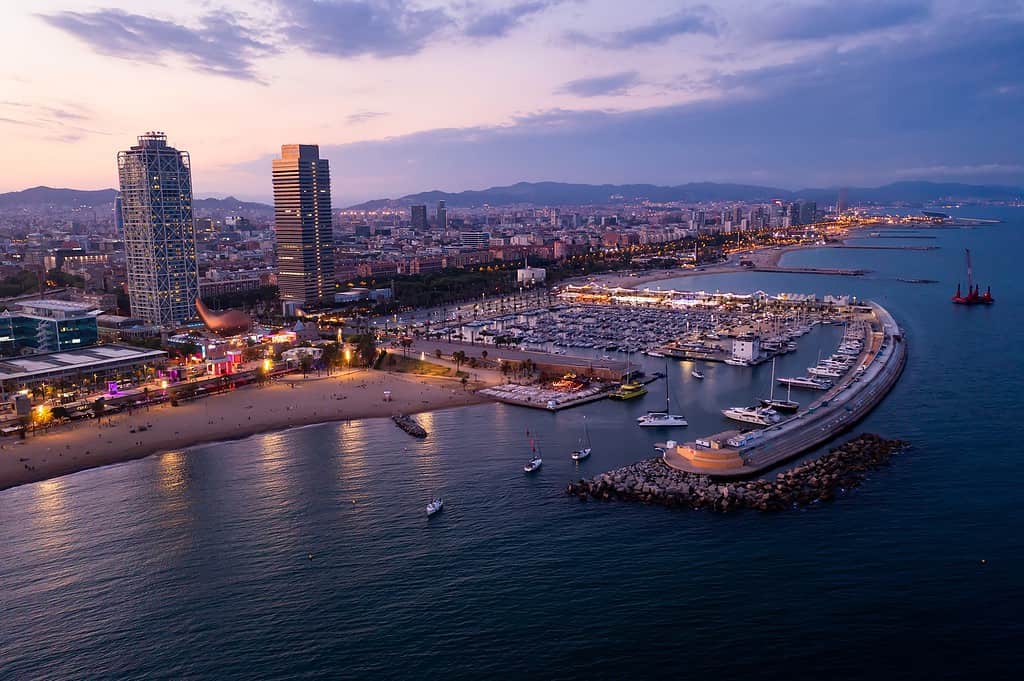
The current king of Spain, Felipe VI, competed in the 1992 Barcelona Olympics sailing team. The Olympic Harbor of the city is pictured here.
©BearFotos/Shutterstock.com
While the encyclopedia lists Spain’s Head of Government as a Prime Minister, the Head of State is a monarch, currently King Felipe VI.
The dashing former prince served in his nation’s military, eventually training as a helicopter pilot. He also competed in the 1992 Barcelona Olympics for Spain’s sailing team.
21. Humming Along to the National Anthem
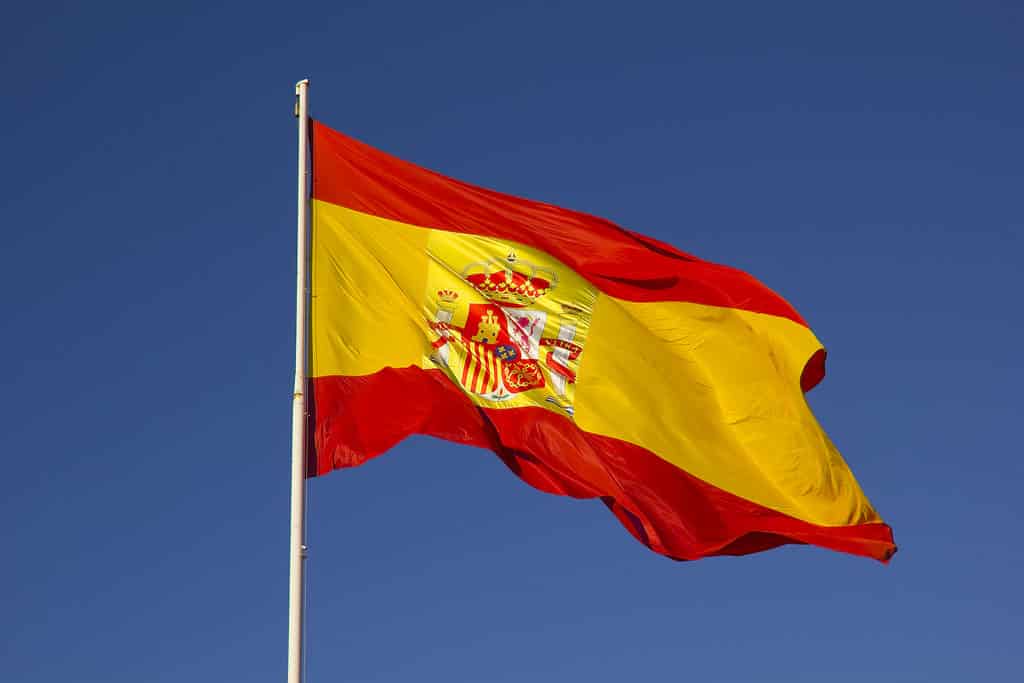
The Spanish national anthem does not, officially, have lyrics. It’s one of a tiny handful of such songs.
©Toniflap/Shutterstock.com
La Marcha Real, Spain’s national anthem, has no official lyrics. It is effectively an instrumental national anthem. Various lists and sources say only two or three other nations have no official lyrics to their national anthems.
Many have tried to set down some official lyrics. Still, historical and political frictions and upheavals have prevented a universally agreeable verbal tribute to the nation. The tradition is, indeed, to hum along with the melody at soccer matches or national ceremonies.
22. A Restaurant That Old Probably Likes Jamón
According to Guinness World Records, Restaurante Botín in Madrid is the oldest restaurant there is. Officially dated to 1725, the restaurant started as a sort of food hostel where guests at the former accompanying inn would bring their own food to cook.
The same oven has been baking delicious fare for tourists and locals for nearly three hundred years. Hemingway was apparently a frequent guest, and the artist Francisco de Goya was supposedly a dishwasher and waiter here before he entered art school.
23. Here-itage, There-itage, Everywhere a Heritage Site
The country of Spain has a staggering 44 UNESCO World Heritage Sites. From Granada to Barcelona, to Sevilla and elsewhere, it’s both a highway and a crossroads for cultures since the start of human migration. One interesting, unconventional spot on that list is the Almaden mercury mines.
24. Hey, Wine Not Have a Drink?
In Ayegui, a town along the Camino de Santiago, there is a spigot provided by the local winery Bodegas Irache. Not a water spigot, but a tap that dispenses strong wine. Travelers along the path can stop and sip some red wine, gratis!
25. First Modern Novel Was Written in Spain
Like most great novels, plays, or other manuscripts in the centuries immediately after the printing press, the first modern novel was only a modest success in its time. Spain’s Miguel de Cervantes wrote the masterpiece Don Quixote.
Published at the start of the 1600s, it is the earliest example of a Weird Al or National Lampoon’s style parody of ancient knights and chivalry tales.
Spain Has Hydroelectricity, Jamón, Tomato Fights and Heritage Sites
These fun facts about Spain show the country thrills, inspires, and chills. History that goes back to the beginning plus arts, food, and landmarks mark out this land and symbolize its global influence.
Thank you for reading! Have some feedback for us? Contact the AZ Animals editorial team.

